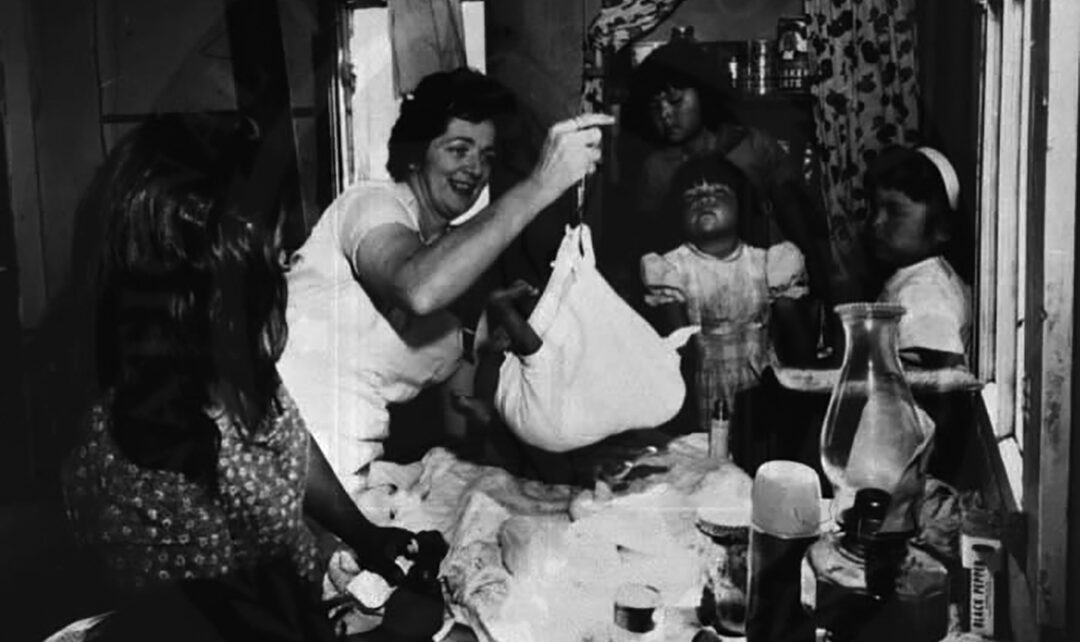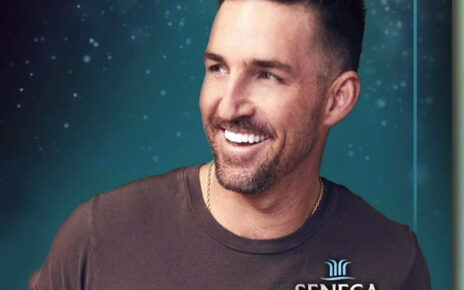Led by Beth Boyd, member of the Seneca Nation and director and professor in the USD clinical psychology program, presenting “Mitákuye Oyás ‘iŋ (We Are All Related): Reflections to Learning to Become a Relative.”
November 30th, 2021 | volanteonline.com
Photo: A visiting nurse weighs an infant in the kitchen of a native household while the mother and several children look on, 1967. Credit: https://pages.uoregon.edu/adoption/topics/IAP.html
USD’s 69th Harrington Lecture was led by Beth Boyd, director and professor in the USD clinical psychology program, presenting “Mitákuye Oyás ‘iŋ (We Are All Related): Reflections to Learning to Become a Relative.”
The Harrington Lecture is an annual event featuring a USD professor established on campus within the College of Arts and Sciences. Featured speakers are recommended by a faculty committee. The lecture is based on the speaker’s scholarly work.
Boyd is a member of the Turtle Clan of the Seneca Nation and the USD Disaster Mental Health Institute (DHMI).
“I aspire to honor and respect the indigenous peoples who were forcibly removed from here and are still connected to this territory. By owning my part in their continued displacement, I am incorporating indigenous knowledge into my work and establishing meaningful reciprocal relationships with indigenous peoples and communities,” Boyd said

Boyd participated in the Board for the Advancement of Psychology in the Public Interest, the Presidential Task Force on PTSD and Trauma in Children and Adolescents, the Commission on Ethnic Minority Recruitment, Retention & Training and the Minority Fellowship Program Training Advisory Committee. She was also president of the APA Society for the Psychological Study of Culture, Ethnicity and Race and the Society for the Clinical Psychology of Ethnic Minorities.
“Over the years, I’ve watched many of my colleagues reflect on liberal arts education, on what they’ve learned, the work they have done over the years, the contributions and their hopes about the future of their fields. And so I have also done a lot of reflection over this last year,” Boyd said.
Boyd said that looking through a lens of liberation psychology at the past fosters healing and awareness of inequality.
“Liberation psychology encourages empowerment, healing and transformation that fosters an awareness of discrimination and inequality, and fortifies individuals strengths. It affirms cultural identities and promotes change to attenuate human suffering and improve people’s lives in multiple contexts, including cultural-historical, gender, sexual orientation, socio-political, geopolitical and other intersecting factors,” Boyd said.
Boyd’s lecture covered the removal of Native children from their homes. Boyd said over 80,000 native children were separated from their families, and said some children were put into foster care, while others were put into residential schools.
“Between 1867 and 1990, thousands of Native American children were taken from their homes and families by the U.S. and Canadian governments. Most of them were taken to Indian residential schools,” Boyd said. “Both, regardless of where they were, had the same goal in mind: to assimilate Native American children into U.S. or Canadian society and to obliterate their familiarity with their native heritage.”
In 1958, the Bureau of Indian Affairs created the Indian Adoption Act in an atte mpt to assimilate Native children and end tribes, Boyd said. The act took Native children away from their families as they were adopted by white families. In 1966, the Adoption Resource Exchange, including private agencies and churches, took over. By the end of the 1970s, one-third of all Native children, estimated at 80,000 to 100,000 children, were separated from their families.
“No one by the late 1950s imagined a solution to the care of Indian children that involved strengthening Indian families and keeping Indian children in their homes. Most government officials deemed Native families inherently and irreparably unfit… Native American spirituality was outlawed at this period of time. It was not legal again until 1978. A child of someone who might have gone to jail for practicing traditional spirituality would be a reason for removal,” Boyd said
Native children were alienated from their culture and often did not have people to look up to within their culture, Boyd said.
“Many adopted families denied the children’s Indian heritage, a change that will change their children’s names and caused them to grow up in communities where they were few of or there were a few of any others who looked like them held similar beliefs, spoke the same language or shared the same culture,” Boyd said.
A study done in 2017 by the Centers for American Indian Alaskan Native Health at the Colorado School of Public Health found that native children adopted away from their families are more likely than their white counterparts to struggle with drug abuse, alcohol addiction, suicide, self harm and other mental health issues, Boyd said.
When the Indian Child Welfare Act was put into place, it set standards for child custody proceedings involving native children to be eligible for membership of federally recognized tribes, Boyd said.
“This came about because tribes started to understand how a large proportion of the children were affected by losing the tribes,” Boyd said. “There was a lot of pressure and congressional testimony documenting the devastating impact that this was having on native children, families and tribes.”
Gary Cheeseman, associate USD professor of curriculum and instruction and American Indian education, presented Boyd with a star blanket and ended the lecture with an honor song.
“This is an unbelievable woman… I am incredibly proud to be native and to be a colleague of hers,” Cheeseman said.
Boyd was born in 1958 and adopted at nine months of age.
“My mother and I lived with my grandmother and my great grandmother in Cattaraugus, one of the two Seneca Nation of Indians reservations in Western New York,” Boyd said. “I was removed from this home and went to several foster homes and the county orphanage. Around the age of three, I was adopted by my adoptive family, a couple who had not been able to have biological children.”
Boyd grew up with her adopted family on an island between Buffalo and Niagara Falls, a mile upstream from the falls, which was Seneca territory no longer in the possession of the nation.
There was a great deal of racism toward Native people in the area, Boyd said.
“All of these experiences made me hate that I was different, because all I really wanted was to fit in to belong and to be one of them, but I did not have the words to explain that to my family. I didn’t have the words to explain to them how this discrimination hurt me, and they did not have the experience to realize how I felt or helped me cope with it,” Boyd said.
In Boyd’s teen years, she was reconnected with her culture for a moment. She felt seen, Boyd said. She again felt seen when her son was born.
“In that moment, I understood what it felt like to be a relative,” Boyd said.
Again, in 1992 when Boyd first came to USD, she felt seen as a Native person.
“For many Native adoptees to process the socialization with white culture tends to produce a negative self image, limiting self concept, low self esteem and a lack of self love, so with all of that, how could you know how to become a good relative?” Boyd said.
The Lakota concept of wellness illustrated in the medicine wheel involves a balance between the natural world and the physical, spiritual and emotional world, along with the spiritual concept of the self, Boyd said. Separation from this causes communal illness.
“Healing in native ways is a communal process of rediscovering balance within self and the harmony between self, the Creator and the natural world in the context of family and community,” Boyd said. “In order to ask for help, I had to realize my connection to others, and accept the help of family and community. I had to recognize I am no more and no less than anyone else.”
Boyd said through the lens of liberation psychology, knowledge is anchored in lived experience and historical experience, and power dynamics of oppression can be challenged and the strength of marginalized and oppressed people can be recognized. This encourages personal agency and engagement in social justice, she said.
“A decolonial psychology would mean moving away from the assumption that the individual is the central unit of analysis in ways that overlook people’s social, economic and political context,” Boyd said. “It’s important to recognize these contexts from the oppression we experience and the healing we take part in… Who I am is relative to those around me.”
Source: http://volanteonline.com/2021/11/harrington-lecturer-reflects-on-indian-adoption-project/




